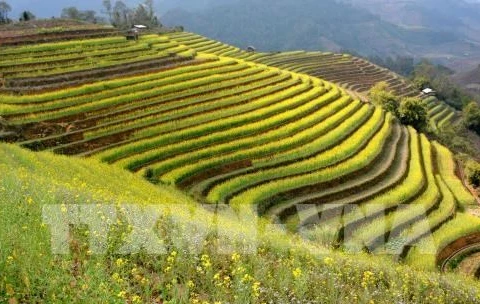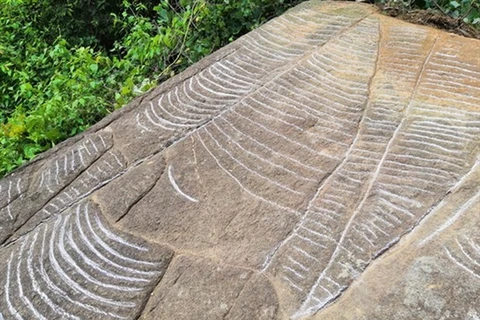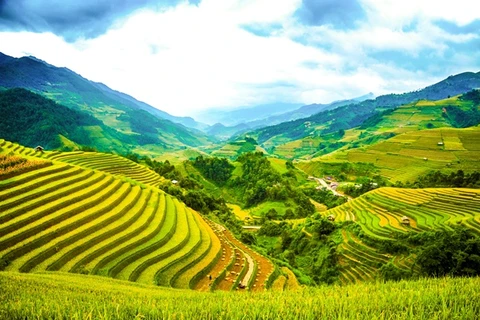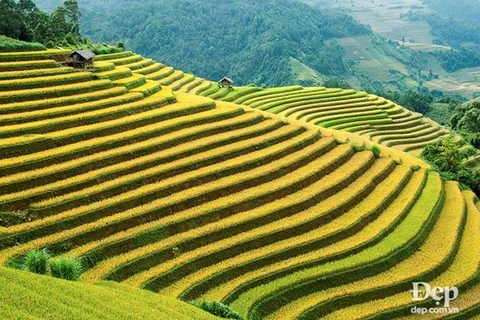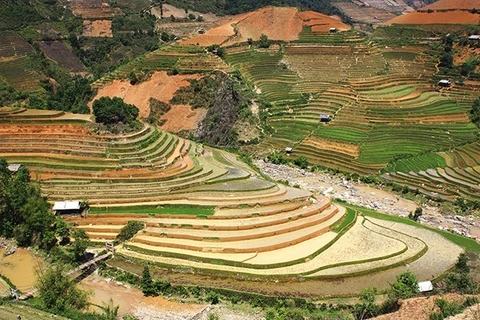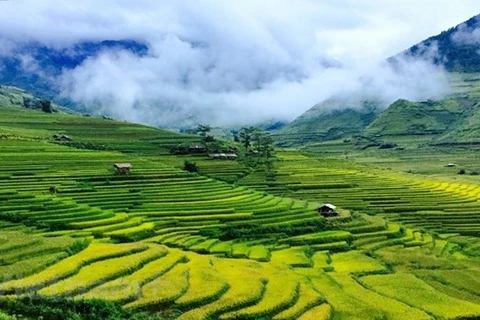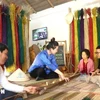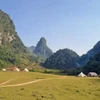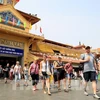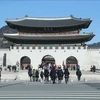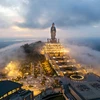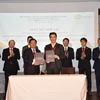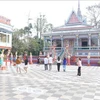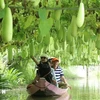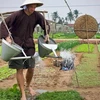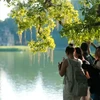Hanoi (VNA) – Famous for its most breathtaking rice terraces, Mu Cang Chai in the northern mountainous province of Yen Bai is a reputable name repeated among travel lovers and photographers, especially in late September and early October - the best time for capturing the most beautiful landscapes of terraced fields in the mountainous district.
More than 300km northwest of Hanoi and 1,000 metres above sea level, Mu Cang Chai is now a familiar destination for tourists.
Mu Cang Chai features enchanting scenery and gracious people whose way of life is so startlingly different than most in the world; it is endearing and lovely to visit such a beautiful, majestic landscape with kind people.
Passing the Khe pass and then the Bo Hon slope, visitors arrive in Tu Le - a popular stopover on the way to Mu Cang Chai.
 In the late afternoon in Lim Mong village, clouds come down and cover thatched roofs lying in the immense rice fields. (Photo: VietnamPlus)
In the late afternoon in Lim Mong village, clouds come down and cover thatched roofs lying in the immense rice fields. (Photo: VietnamPlus)
Tu Le sticky rice is a specialty because it can only be grown on terraced fields one crop a year. When the food is cooked well, it is very sticky and fragrant. Everyone who eats once wants to eat it again.
Tu Le is also the beginning point of the majestic Khau Pha Pass, which is known as one of the four great passes in the country. Khau Pha means "heaven horn."
The local Mong ethnic group has used that word to describe Khau Pha as a horn rising to the blue sky, and also to indicate the degree of danger. The whole pass is more than 20km long, with mostly cloudy all year round.
Along the road to Mu Cang Chai town are terraced fields stretching from the top of the mountain down to streams.
Mu Cang Chai terraced fields have long been well-known and considered a must-visit place for tourists to the northwestern region of Vietnam. These are the terraced fields on mountain slopes, which cover an area of about 2,200 hectares in the three communes of La Pan Tan, Che Cu Nha and De Xu Phinh in Mu Cang Chai district cultivated by the Mong people for centuries.
 Seeing the panoramic view of the waves of rice on terraced fields from Khau Pha Pass always brings great emotion for paragliding pilots. (Photo: VietnamPlus).
Seeing the panoramic view of the waves of rice on terraced fields from Khau Pha Pass always brings great emotion for paragliding pilots. (Photo: VietnamPlus).
Viewing from La Pan Tan, visitors can see terraced fields around, and primeval forests in the distance.
Likened to the fingerprint of the sky, Mu Cang Chai terraced fields in the northern mountainous province of Yen Bai are artistic architectural work with full of creativity of the Mong ethnic community living on this land.
In the ripe rice season, terraced fields look like golden waves winding on the middle of high hills.
End of September and early October is the best time for capturing the most beautiful landscapes of stepped rice fields in Mu Cang Chai.
Everywhere in Mu Cang Chai are rice terraces of multi-layers that create picturesque Mu Cang Chai landscapes.
 In the ripe rice season, terraced fields look like golden waves winding on the middle of high hills. (Photo: VietnamPlus)
In the ripe rice season, terraced fields look like golden waves winding on the middle of high hills. (Photo: VietnamPlus)
The local terraces are among the 2,500 hectares recognised as national heritage sites in 2007 by the Ministry of Culture, Sports and Tourism and a special national site by Prime Minister Nguyen Xuan Phuc in January this year.
The locality is about 1,000 metres above sea level, making it impossible to cultivate wet rice the same way as in deltas. Local residents grow rice in terraced fields to stop water flowing downhill.
Terraced fields in Mu Cang Chai are beautiful year-round. Visitors in March can see glittering ponds before locals transplant rice seedlings from April to May. After May, the hills are covered in green until the fields start to turn yellow with ripe rice in early September.
During the harvest in October, the yellow rice fields stand out amidst green forests./.
 During the harvest in October, the yellow rice fields stand out amidst green forests (Photo: Vietnamplus)
During the harvest in October, the yellow rice fields stand out amidst green forests (Photo: Vietnamplus) 


